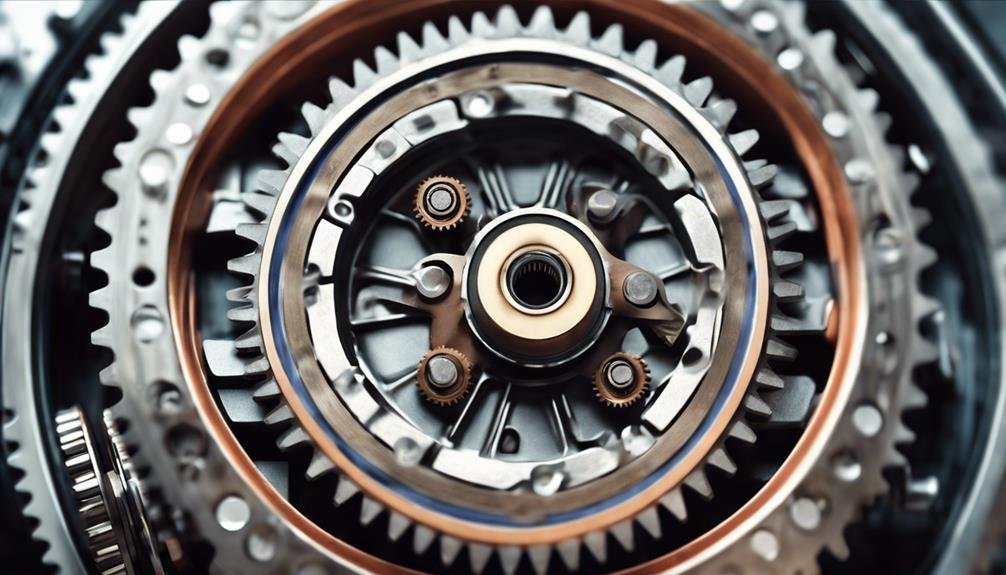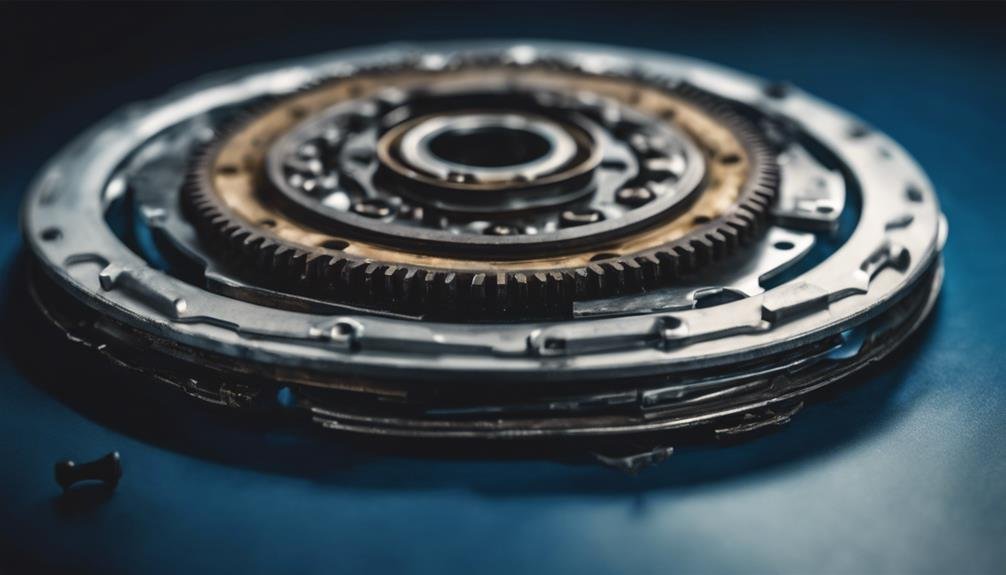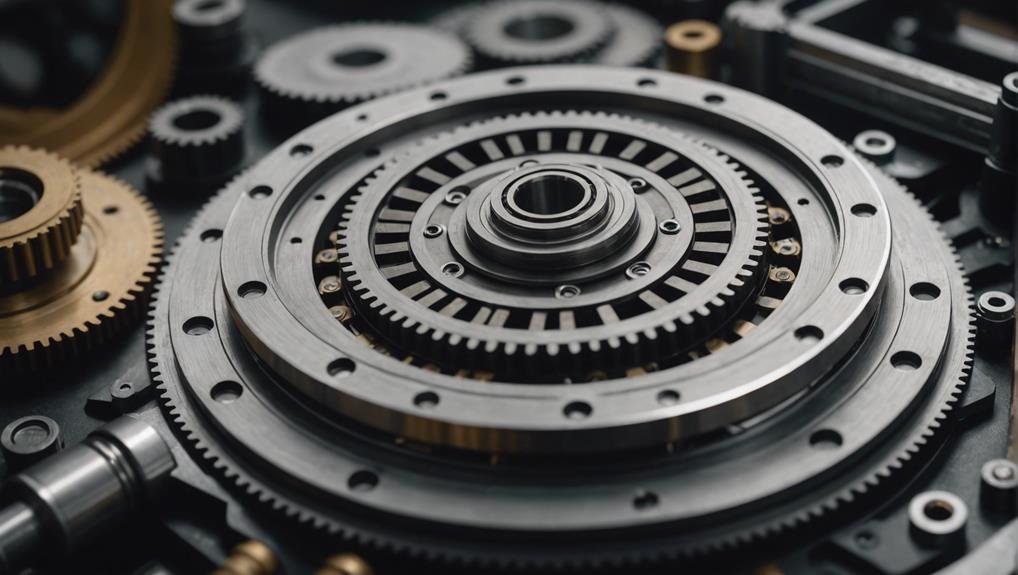As you shift gears, the clutch, a vital component of your vehicle's transmission system, enables a smooth transfer of power from the engine to the wheels, facilitating seamless gear changes and preventing engine stalling and transmission damage. The clutch relies on the clutch disc, pressure plate, and flywheel to create friction and maintain pressure for reliable power transfer. When you press the clutch pedal, it disengages engine power, allowing for smooth gear shifts, and releasing it reconnects the power. By understanding how the clutch works, you'll be better equipped to identify potential issues and take steps to prevent them, and by exploring further, you'll learn more about this complex and crucial component.
Key Takeaways
- A clutch is a component in manual transmission vehicles that facilitates smooth power transfer between the engine and wheels.
- The clutch system consists of the clutch disc, pressure plate, and flywheel, designed for smooth power transfer and reliable transmission.
- When the clutch pedal is engaged, it disconnects engine power, allowing for smooth gear changes, and releasing the pedal reconnects the power.
- The clutch's primary function is to control power flow, facilitate seamless gear shifts, and prevent engine stalling and transmission damage.
- Proper maintenance, including regular inspections and timely replacement of worn components, is crucial to extend the clutch's lifespan and prevent costly repairs.
Clutch Components and Design
Your manual transmission's clutch system relies on three key components: the clutch disc, pressure plate, and flywheel, which work together to transfer power from the engine to the wheels.
These clutch components are carefully designed to facilitate smooth power transfer, engagement, and disengagement.
The clutch disc, a friction-based component, creates the necessary friction between the flywheel and pressure plate to enable power transfer.
Inside the pressure plate, springs maintain pressure on the clutch disc against the flywheel during operation, ensuring reliable power transmission.
Proper alignment and tension of these clutch components are crucial for smooth gear changes and overall performance.
When you shift gears, the clutch design allows for slipping and disengagement of power transmission between the engine and wheels, enabling seamless shifts.
How Clutch Engages and Releases
As you press the clutch pedal, the clutch engages, disconnecting the engine's power from the transmission, allowing you to shift gears smoothly. This critical disengagement is essential for gear changes, as it prevents the engine's power from interfering with the transmission's operation.
When the clutch engages, the engine power is temporarily disconnected from the wheels, enabling you to shift gears without grinding or damaging the transmission. As you release the clutch pedal, the clutch releases, reconnecting the engine power to the transmission, allowing the vehicle to move. This release mechanism guarantees a smooth transfer of power to the wheels, enabling you to accelerate or decelerate smoothly.
The clutch's engagement and release require precise coordination between the clutch pedal and gear selection, ensuring seamless gear changes and efficient power transfer. By disengaging and re-engaging the engine power, the clutch facilitates smooth gear shifts, making your driving experience more comfortable and efficient.
Clutch Functions and Purposes

Controlling the flow of power between the engine and wheels, the clutch plays an essential role in facilitating seamless gear shifts, preventing engine stalling, and protecting the transmission from damage.
As you operate a manual transmission, the clutch works to disconnect the engine from the transmission, allowing you to change gears smoothly. This temporary disconnection prevents the engine from stalling and safeguards the transmission from damage.
The clutch system achieves this by using friction linings to regulate the connection between the engine and wheels. When you press the clutch pedal, you're disengaging the engine from the transmission, allowing you to shift gears without grinding or damaging the transmission.
The friction between the clutch and the flywheel enables the power flow to be interrupted, giving you control over the power transfer. By mastering the clutch, you'll be able to modulate acceleration, ensuring efficient power transfer and a smoother driving experience.
Common Clutch Problems and Issues
Clutch problems can creep up on you, and it's important to recognize the warning signs before they leave you stranded on the side of the road. You mightn't notice, but common clutch problems like wear and tear, broken cables, leaks, misalignment, and air in the line can affect your vehicle's performance.
Proper care can extend your clutch lifespan to up to 80,000 miles, but neglect can lead to premature failure. Tips like changing gears quickly and avoiding riding the clutch can help prevent issues. However, if you notice slipping or sticking, it's necessary to address the problem promptly to avoid potential failure.
Don't ignore these signs, as timely attention can save you from costly repairs. Understanding how different types of clutches, such as friction, multiple plate, cone, and centrifugal, work is important for diagnosing issues and ensuring proper maintenance.
Stay vigilant, and you'll be able to identify and address clutch problems before they become major headaches.
Clutch Maintenance and Repair

By staying on top of regular inspections and addressing any unusual noises or vibrations promptly, you can extend the life of your clutch and avoid costly repairs down the road. Proper clutch maintenance involves more than just checking the clutch pedal; it's vital to inspect the pressure plate, clutch disc, and flywheel regularly to prevent premature wear.
| Clutch Component | Maintenance Tips |
|---|---|
| Clutch Pedal | Avoid excessive slipping or riding to prevent wear |
| Pressure Plate | Inspect for signs of wear, clean or replace as needed |
| Clutch Disc | Check for uneven wear, replace if damaged |
| Flywheel | Inspect for scoring or wear, resurface or replace as needed |
| Overall Clutch System | Regularly inspect and address unusual noises or vibrations |
Proper use of the clutch pedal, avoiding excessive slipping or riding, is vital for clutch longevity. Timely replacement of worn-out clutch components can prevent costly repairs and ensure smooth operation. If you're unsure about any aspect of clutch maintenance or repair, don't hesitate to seek professional help to avoid further damage.
Frequently Asked Questions
What Is the Purpose of a Clutch?
You might wonder, what's the purpose of a clutch? Simply put, it's to connect and disconnect the engine's power to the wheels, allowing you to shift gears smoothly without stalling the engine.
How Does a Clutch Work Simple?
You're wondering how a clutch works in simple terms! You press the pedal, disengaging the engine from the transmission, allowing gear changes; releasing the pedal reconnects power, and you're moving smoothly again.
When Should I Use the Clutch While Driving?
When driving, you should use the clutch when shifting gears, coming to a stop, or starting from a standstill to smoothly transfer power and prevent stalling or transmission damage.
What Happens When You Press the Clutch?
"When you press the clutch, you're disengaging the engine from the transmission, temporarily breaking the connection between the engine and wheels, allowing for smoother gear shifts and preventing transmission damage, giving you control."
Conclusion
You now have a thorough understanding of how a clutch works, from its components and design to its functions and common problems.
By recognizing the signs of wear and tear, you can take proactive steps to maintain and repair your clutch, ensuring a smooth and efficient driving experience.
Remember, a well-maintained clutch is vital for your vehicle's performance and longevity, so stay vigilant and address any issues promptly to avoid costly repairs down the road.
